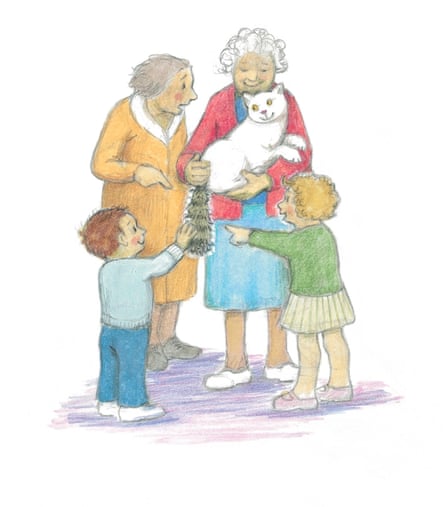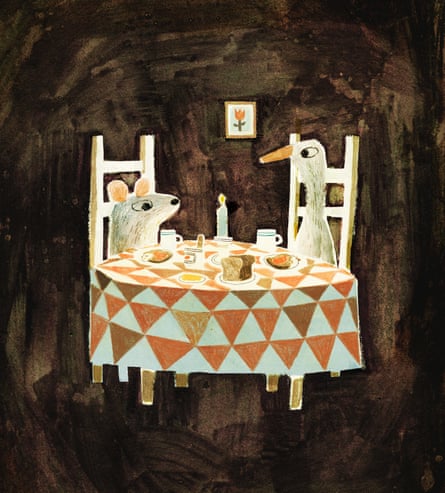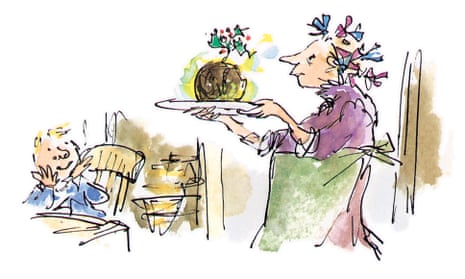A Christmas Carol by Charles Dickens, illustrated by Quentin Blake (Pavilion £14.99), is an uplifting version of Dickens’s classic, bound in scarlet, with which to get Christmas off to a festive start. Dickens and Blake turn out to be a canny pairing – what they have in common is boundless imaginative energy. Blake’s Scrooge is first encountered bent double over his desk. Everything about him and his environs is greyish save for the pile of golden coins upon which he is dolefully focused. The first ghost in the story is rendered as comic and alarming – a mix Blake has down to a fine art. Hair standing on end, desperate mouth – the ghost is chaos on the move. But the most appealing picture is of Scrooge transformed – a benign Christmas figure, if not quite qualifying as a wise man with holly in his hair, satsumas and Christmas pud at his feet (five up – and all the family).
The Wolf, the Duck & the Mouse by Mac Barnett, illustrated by Jon Klassen (Walker £12.99), is a model of storytelling: a simple, compelling tale of two animals, a duck and a mouse, who make themselves at home in a wolf’s belly. Barnett’s nice distinction is that being swallowed is not the same as being eaten. The belly is claustrophobic. It lacks mod cons and daylight but the animals do surprisingly well in their dark digs and there are amazing developments to come. Hassen’s edgy, subtle, muted drawings illustrate this story marvellously (three-year-olds of steady character and up).

Katinka’s Tail by Judith Kerr (Harper Collins £12.99) is a welcome and heartwarming postscript to the inimitable Mog books. Bravo to 94-year-old Kerr and her ninth cat, Katinka, engagingly encountered here. Kerr insists Katinka is a perfectly “ordinary” snowy white cat, apart from her eye-catching tabby tail. Might Kerr be protesting too much? She starts off by showing, with trademark subtlety, the ordinary ways in which a human/feline relationship can flourish before extraordinarily taking off into orbit as Katinka’s tail turns out not to be tabby after all but, like the story, pure gold (three up).
Play in a Box: Everything you Need to Put on Your Own Show! (National Theatre 12.99) is a wonderful idea organised in an attractive and unfussy way. It consists of a box, not much bigger than a brick, inside which you will find a Stagecraft Handbook, a list of possible characters and – the importance of this cannot be overemphasised – a “plot twist book” to introduce a host of problems young players will need to solve on stage: “SOMEONE ON YOUR TEAM JUST TURNED AGAINST YOU. Who was it? A Friend or a Hero? Why? Was it something you said or did?” All these prompts will nudge the imagination – if it is not in overdrive already. It even contains tickets to fill in and distribute as soon as you are ready for your play’s first night (six up).
A Thousand Billion Things (and Some Sheep) by Loïc Clement and Anne Montel (Words & Pictures £12.99), is an intriguing, sophisticated, beautifully executed book about a child growing up in a world where there is, arguably, too much choice. It is presented as a form of hide-and-seek in which the reader is asked to search for a green jumper, identify a pile of cream cakes, spot rubber ducks from pages of minutely detailed detritus. It is a nice joke that the child in question cannot sleep because counting sheep is too samey – not enough choice. A diverting addition to any picture book library (four up).
Dragons: Father and Son by Alexandre Lacroix, illustrated by Ronan Badel (Words & Pictures £11.99), is expertly orchestrated, a yarn about initiation in which a young dragon forgoes dragonish violence in favour of helping a fisherman on a beach to get a barbecue going. How will his dragon dad react to this benign rebellion? The young dragon was supposed to have set fire to a building to mark his coming of age. In the end, vanity turns out to be a dragon’s best friend. When the dragons contemplate their appearance, they revel in their unusual, orange, scaly bottoms and hairy noses – all the better for snorting with (three up).

I remember having a book like Mixed-Up Masterpieces: Funny Faces (Nosy Crow/The British Museum £9.99) as a child – I adored it. But my book was inferior. This book is divided into three horizontal sections so that depending upon how you flip the pages, different faces emerge. Involving the British Museum – and plundering its ancient artefacts with clear, detailed photographs – refines the idea and gives it class and dash. Turning at random now, I see an ancient bald head (top section), a terrific, faded, handlebar moustache (middle section) and (bottom section) a pale blue chin with a curvy, enigmatic red smile. Endless fun (two up).
On the face of it, The Twelve Days of Christmas, illustrated by Anna Wright (Faber £9.99), looks like a conservative little book, but look twice. There are frogs playing hula-hoop with the five gold rings and the swans are aristocrats with wings like the endpapers of a Venetian notebook. The eight maids-a-milking turn out, in a witty conversion, to be famished piglets and the dancing ladies are gorgeous butterflies. It is a nice new take on an old favourite and is asking to be squeezed into a stocking (all ages).
Pick a Pine Tree by Patricia Toht, illustrated by Jarvis (Walker £11.99), is a sprightly, unashamedly Christmassy picture book in which a family ventures forth in the snow to choose a Christmas tree. It will take a child through the merry mission of purchasing the tree, of balancing it and perhaps of offering it a drink – and then of decorating it. The book has an unstrained, jaunty feel that will appeal to young children and get them into the mood for transformation – the celebratory moment when a pine sapling turns into a Christmas tree (three up).

Comments (…)
Sign in or create your Guardian account to join the discussion